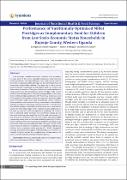| dc.contributor.author | Barugahara, Evyline Isingoma | |
| dc.contributor.author | Samuel, K Mbugu | |
| dc.contributor.author | Edward, G Karuri | |
| dc.date.accessioned | 2024-01-31T10:40:34Z | |
| dc.date.available | 2024-01-31T10:40:34Z | |
| dc.date.issued | 2018-01 | |
| dc.identifier.citation | Isingoma, B. E., Mbugua, S. K., & Karuri, E. G. (2018). Performance of Nutritionally Optimised Millet Porridges as Complementary Food for Children from Low Socio-Economic Status Households in Bujenje County, Western Uganda. | en_US |
| dc.identifier.uri | DOI: 10.15226/jnhfs.2018.001123 | |
| dc.identifier.uri | https://hdl.handle.net/20.500.12504/1576 | |
| dc.description.abstract | Lack of proper complimentary foods continues to be a problem
in many parts of the world, especially among low socio-economic
status households. The main objective of this study was to evaluate
the effect of optimised millet porridges on the nutritional status of
moderately malnourished children. The study was a closed cohort
study involving 93 moderately wasted children aged 7-36 months and
their mothers/caretakers. Thirty two children recruited from Ntooma
village centre were fed on traditional millet porridge as the control
while 30 from Karongo and 31 from Kiryamyongo village centres were
fed on millet porridges optimised with 7% moringa leaf powder and
17% pumpkin flesh powder respectively. Optimised millet porridges
were fermented using lactic acid fermentation starter cultures.
Anthropometric measurements, dietary assessments and morbidity
patterns of children in the study were monitored for 4 months. One
way ANOVA (Analysis of Variance) and Chi-square tests were used to
analyse the effect of porridges on the nutritional status of children. In
all cases a p value of < 0.05 was regarded as significant. All children
fed on optimised millet porridges recovered from wasting by the
6th week and being underweight by the 12th week, compared to 26
and 25 percent of children that were still wasted and underweight
respectively among those fed on traditional millet porridges. Children
fed on traditional millet porridge had their Height for Age (HAZ) scores
deteriorate while those on optimised millet porridges had their HAZ
scores improved. Diarrhoea incidences were significantly high among
children fed on traditional millet porridge (P = 0.006). Fermented
moringa and fermented pumpkin millet porridges can therefore be
adopted as better options for complementary feeding among low
socio-economic status households of Western Uganda. | en_US |
| dc.language.iso | en | en_US |
| dc.publisher | Journal of Nutritional Health & Food Science | en_US |
| dc.subject | Performance | en_US |
| dc.subject | Nutritionally optimised | en_US |
| dc.subject | Complementary food | en_US |
| dc.subject | Low socioeconomic | en_US |
| dc.subject | Western Uganda | en_US |
| dc.title | Performance of nutritionally optimized millet porridges as complementary food for children from low socio-economic status households in Bujenje county, western Uganda | en_US |
| dc.type | Article | en_US |

